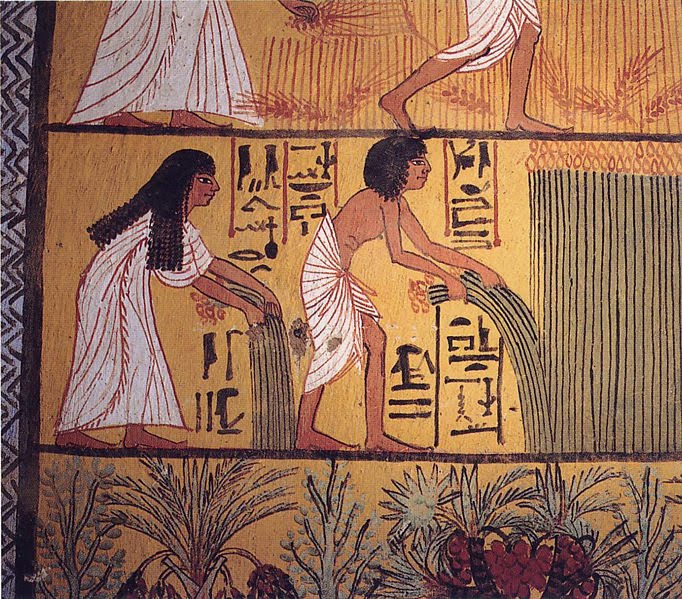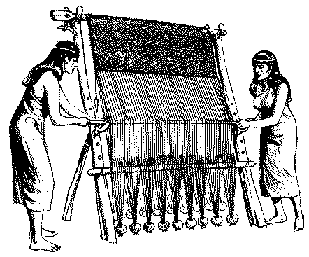“Repent ye, repent ye, and seek no more to destroy my servants whom I have sent unto you to declare good tidings.” (Helaman 5:32)
- They enjoyed a time of great righteousness, richness, prosperity, and peace in the history of the Book of Mormon;
- In listing all the combined riches of the Nephites and Lamanites Mormon listed that they had much gold, silver, crops, herds, and that ” …their women did toil and spin, and did make all manner of cloth, of fine-twined linen and cloth of every kind, to clothe their nakedness. And thus the sixty and fourth year did pass away in peace.” (Helaman 6:13)
- Eventually all the people, Lamanite and Nephite, became wicked and the Gadianton robbers gained power among them because “the Lord had blessed them so long with the riches of the world that they had not been stirred up to anger, to wars, nor to bloodshed; therefore they began to set their hearts upon their riches; yea, they began to seek to get gain that they might be lifted up one above another; therefore they began to commit secret murders, and to rob and to plunder, that they might get gain. ” (Helaman 6:17)
- Harvesting, spinning, and weaving cloth was something that these women learned from their mothers and grandmothers. Years and years before these women were born Zeniff (a Nephite leader) “.. did cause that the women should spin, and toil, and work, and work all manner of fine linen, yea, and cloth of every kind, that we might clothe our nakedness; and thus we did prosper in the land—thus we did have continual peace in the land for the space of twenty and two years.” (Mosiah 10:5)
- Linen is a material that is made out of flax. There has been some discussion among scholars about the authenticity of the Book of Mormon because flax does not grow native in the Northern Hemisphere and thus would not have been available for Lamanite and Nephite women to spin into linen. Yet John L. Sorenson in his article “Possible ‘silk’ and ‘linen’ in the Book of Mormon” explains that,
“Linen is defined as a cloth, often quite stiffish and hard-wearing, made of fibers from flax or hemp plants prepared by soaking and pounding. Although the flax plant was apparently not known in pre-Spanish America, several fabrics were made from vegetable fabrics that look and feel much like European linen. One was made from fibers (called henequen) of the leaf of the ixtle (maguey or agave plant), but fibers from the yucca and other plants gave similar results. Conquistador Bernal Diaz said of henequen garments that they were “like linen.” Bark cloth, made by stripping bark from the fig tree and soaking and pounding it, was common in Mesoamerica and also has some of the characteristics of linen.
So it is probable that Book of Mormon women did not actually use flax to make linen but used similar fibers to produce a material similar to linen.
- The production of flax and other materials (like silk that is mentioned in Alma 1:29) were very , very labor intensive and took months of work to produce. Since we know that at this time that both the Lamanites and the Nephites “…did have free intercourse one with another, to buy and to sell, and to get gain, according to their desire (Helaman 6:8) “ it is interesting to think that perhaps both Lamanite and Nephite women worked together to make these fine-twined linens and other types of cloths. If anything they must have traded their materials back and forth between their lands.
- In Exodus 39:27- 29 it mentions that the temple robes that Aaron and his sons wore were made from linen.
- Ezekiel 44:17 also specified that priests were only to wear linen in Solomon’s temple.
- In Revelation 19:8 the “Bride of the Lamb” is clothed in “fine linen” and it states “for the fine linen is the righteousness of the Saints.” Also it is specified that the armies of the Lord, mentioned in Revelation 19:14, will also be clothed in fine linen.
- In Mathew 27:59 we learn that when Christ was brought down from the cross he was wrapped in a linen cloth;
- John 19:40 specifies that Christ was wound and buried in linen clothes.
“ The temple provides purpose for our lives. It brings peace to our souls—not the peace provided by men but the peace promised by the Son of God when He said, ‘Peace I leave with you, my peace I give unto you: not as the world giveth, give I unto you. Let not your heart be troubled, neither let it be afraid.’” Source
- Why does Mormon mention women’s production of cloth in his list of the people’s riches? What does this tell us about the important role women played in Book of Mormon life and society?
- The processes of harvesting, spinning, weaving and sewing cloth require a great deal of physical labor and time comparable to any field or husbandry work that men traditionally did. Egyptian Goddesses were even sometimes portrayed as spinning and weaving. Why do you think that these processes were usually “women’s work” and not men’s?
- Do you think that having temples in a country, a state or a city, brings added peace to that place?
- How does temple service bring peace to your life?





fastinating connections, once again, great post.
I agree with the fascinating connections! I was actually really impressed at how much significance you were able to discover in just a few verses.
I always enjoy reading your posts, even if I don't always comment 🙂 But this one was so impressed I couldn't help myself!
You encourage me to undertake a deeper study of the scriptures.
My Soul Delighteth
Very insightful. I've been following you for about a year and I love the research you've done. It inspires me to look for more amazing women to look up to in the scriptures and church history. Thank you.
Love your insight. I enjoyed reading it. I know there are many amazing women in the scriptures. Sometimes we just have to look a little harder to find them. I think it is interesting that cloth and clothing were considered treasures in the Book of Mormon times. I think that tells us something about where our hearts should be and that we have the same types of problems that they did.
Thank you for sharing. I am a dedicated follower of your blog. It inspires me and it is never a waste of time to head over here. I am always mentioning this blog to all the wonderful ladies in my life. I just can't stop talking about it.
These women remind me of the early sisters who worked and sacrificed to build the Kirtland and Nauvoo Temples. Wonderful post!
Interesting-thanks for the insight.
I love this post. I have been reading about the roles of women in the scriptures since I took up your challenge.
I found that in Proverbs 31 we can learn the extent of the responsibilities of the women of that time and possibly in the time of women in the book of Mormon.
Proverbs 31 seems to imply that a goal of all women is to be worthy in the sight of God, to be virtueous and faithful in all of her endeavors.
Proverbs 31:13 She seeketh wool, and flax, and worketh willingly with her hands.
In Proverbs 31:16 The woman is given the responsibility to purchase land that will be used to plant a vineyard,she will no doubt work side by side with her husband to clear, and till and plant.
16 She considereth a field, and buyeth it: with the fruit of her hands she planteth a vineyard.
In verse 17, she is no stranger to hard work.
17 She girdeth her loins with strength, and strengtheneth her arms.
In vs 18 just like women now, she is responsible for the family accounts and budget.
18 She perceiveth that her merchandise is good: her candle goeth not out by night.
Vs 19 details her skills in producing fine wools, as a result of the shearing sheep, that most likely her and her husband are responsible for.
19 She layeth her hands to the spindle, and her hands hold the distaff.
She keeps her covenants with God to take care of all those in need.
20 She stretcheth out her hand to the poor; yea, she reacheth forth her hands to the needy.
This verse implies that the tapestries and cloth of purple are made for the temple.
22 She maketh herself coverings of tapestry; her clothing is silk and purple.
My eyes are opened now to the beauty of this. In the past and even recently I have looked at these scripures and also the ones in the book of Mormon, and I felt a little disappointed that for all of their worth and hard work, these women weren't named. The words used to describe their work, toil, was a demeaning word. But as the Heavenly Father said to Adam and Eve together, from the sweat of your brow will ye labor. Was it a punishment to work hard for your livelihood.I believe that the riches described were the abundance describe in Malachi concerning bringing all to the storehouse.
Thanks for this post.
RGG,
Thank you for those wonderful insights into the the woman in Proverbs. I hadn't put it together that she also is mentioned gathering flax and making things for the tabernacle. THat is great!
This morning, before I read your post, I had read Exodus 28:3 in my own scripture reading and was fascinated by the description of those who sew as "wise-hearted" (Exodus 35:10 and 25 use the same phrase). It actually made me think of your knitting post. I was thinking about how all of our creative efforts as homemakers, whether they're for an overtly holy project like making temple vestments or for more homely purposes like clothing our children,can be spiritual expressions, or wise-heartedness.
That's brilliant! I agree with you, I bet they were making temple garments. I never even looked at those verses very closely before. I'll definitely see them differently now.
My husband and I were talking about this post and he shared this scripture I think you will find very interesting too. Mark 14:46-52 paying specific attention to verses 51 and 52 just out of the blue this man is mentioned in a linen cloth. Interesting to think about. Thanks for your posts I am always so edified! I love pulling out my scriptures and reading along finding more and more. Thank you thank you for sharing your talents.